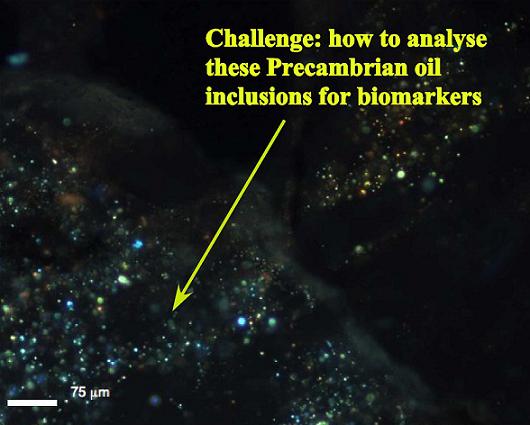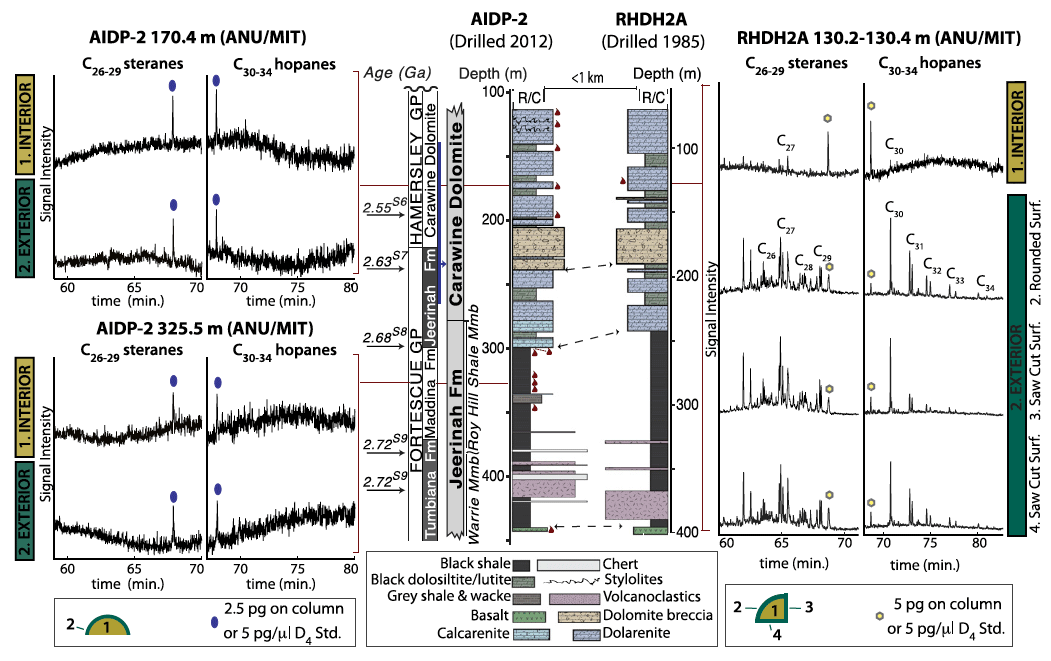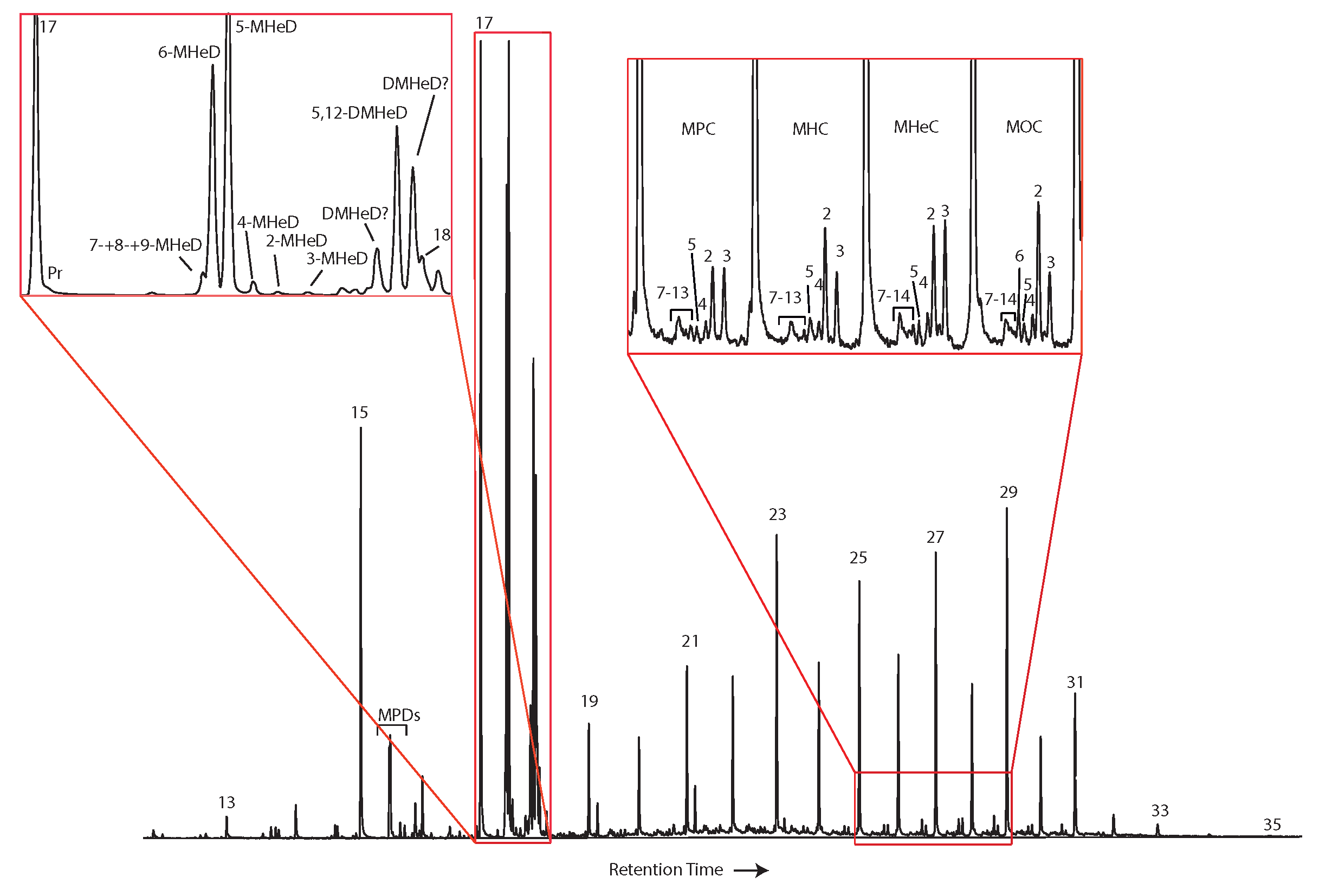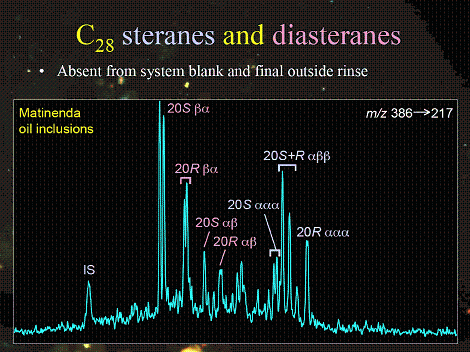Fluid inclusions and molecular fossils as indicators of evolution in the Precambrian (astrobiology)
Precambrian oil-bearing fluid Inclusions
We use oil inclusions as biogeochemical time capsules which retain information for billions of years. Crude oil formed during the Archaean and Proterozoic (>1.0 billion years ago) due to burial and heating of organic matter. In most places this oil has subsequently been lost through leakage, thermal alteration and biodegradation. Sometimes, tiny samples of the oil was trapped in mineral grains as fluid inclusions. We have devised methods of analysing this oil, the chemistry of which (e.g. biomarker distribution) tells us information about the original organic matter in the >1.0 billion year old rocks. In the future we will apply femtosecond laser micropyrolysis gas chromatography-mass spectrometry to individually characterise single fluid inclusions and microscopically-discernible Precambrian organic matter.
We have firmly established the extraction of biomarker molecules from Palaeoproterozoic oil-bearing fluid inclusions as a method that allows us to trace evolution of Earth's early history (Dutkiewicz et al, 2006; George et al., 2008). This new method avoids the potential contamination problems associated with the shale-hosted hydrocarbons and as oil inclusions are found in a variety of rocks and minerals, they can thus provide new insights into biological evolution and palaeoenvironments during critical stages of Earth's history. We have recently shown the presence of trace amounts of hopanes and steranes in oil inclusions trapped in carbonate veins cutting Precambrian rocks (Peters et al., 2018).

Dutkiewicz, A., Volk, H., George, S.C., Ridley, J. and Buick, R. (2006) Biomarkers sealed in oil-bearing fluid inclusions trapped before the Great Oxidation Event. Geology 34, 437-440.
George, S.C., Volk, H., Dutkiewicz, A., Ridley, J. and Buick, R. (2008) Preservation of hydrocarbons and biomarkers in oil trapped inside fluid inclusions for >2 billion years. Geochimica Cosmochimica Acta 72, 844-870.
Peters, C.A., George, S.C. (2018) Hydrocarbon biomarkers preserved in carbonate veins of potentially Paleoproterozoic age, and implications for the early biosphere. Geobiology 16, 577-596.
Fine-grained Precambrian Rocks
We work on Precambrian rocks of many ages, including Neoproterozoic, Mesoproterozoic, Paleoproterozoic and Archean. We are interested in how best to analyse these rocks for biomarkers, given that it is very easy to end up with a contaminated signal. We have worked with others to demonstrate that earlier reported data on Archean biomarkers from fine-grained shales in the Pilbara must have been due to contamination (French et al., 2015). Similarly, by doing careful slice experiments we have shown that the Neoproterozoic interglacial Datangpo Formation and the post-glacial Doushantuo Formation in South China contain very low or zero or no hopanes or steranes, contrary to earlier studies which showed high amounts that be be due to contamination (Ai Jiayi, unpublished data; Ai et al., 2018). We are working on characterising and explaining the prominent unresolved complex mixture (UCM) that is prevalent in many Mesoproterozoic rocks.
 Hopanes and steranes in rock extracts from AIDP-2 (clean) compared with RHDH2A (contaminated). Comparison and lithological correlation of the intersected stratigraphy of AIDP-2 (Center Left) and RHDH2A (Center Right).
Hopanes and steranes in rock extracts from AIDP-2 (clean) compared with RHDH2A (contaminated). Comparison and lithological correlation of the intersected stratigraphy of AIDP-2 (Center Left) and RHDH2A (Center Right).
French, K.L., Hallmann, C., Hope, J.M., Schoon, P.L., Zumberge, J.A., Hoshino, Y., Peters, C.A., George, S.C., Love, G.D., Brocks, J.J., Buick, R. and Summons, R.E. (2015) Reappraisal of hydrocarbon biomarkers in Archean rocks. Proceedings of the National Academy of Sciences USA 112, 5915-5920.
Ai, J., Zhong, N., George, S.C., Wang, T., Zhang, Y. (2018) Tracing the redox evolution of the palaeo-ocean through the Late Neoproterozoic in South China: insights from trace elemental proxies.In: 20th Australian Organic Geochemistry Conference Program and Abstracts, 3–7 December 2018, Australian National University, Canberra (eds. Edwards, D.S., Grosjean, E., Brocks, J.J. and van Maldegem, L.), p. 36-38. Record 2018/44. Geoscience Australia.
Astrobiology
We work on analogue environments that inform about the search for life on other planets and moons. For example, recently we have been working on biomolecules from fossilised hot-spring sinters in the Taupo Volcanic Zone (TVZ), New Zealand and El Tatio in Chile. Results show that all samples contain opaline silica and contain hydrocarbons indicative of a cyanobacterial origin.These data show that hot spring sinters can preserve biomolecules from the local microbial community, and that crystallinity rather than age may be the determining factor in their preservation. This research provides support for the exploration for biosignatures in 3.5 Ga opaline silica at Columbia Hills, where biomolecules may be preserved. This work will soon be submitted for publication in Astrobiology (Bonnie Teece et al.).

Partial m/z 57 mass chromatogram of an El Tatio sample.
Projects/students:
Jiayi Ai: Late Neoproterozoic organic-rich sediments in South China: Insight into records of paleo-ocean chemistry and biogeochemistry
Bonnie Teece: Stromatolite composition and the Great Oxidation Event; Modern hot springs biomarker preservation, as Mars analogue
Carl Peters: Deep Time Biomarkers: A Study of Organic Matter and Fluid Inclusions in Precambrian Rocks

